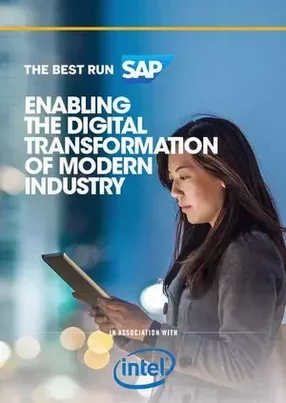How SAP works with Intel to embrace a digital transformation
Technology continues to transform business across all industries and in response, businesses the world over have changed their entire perspective and approach to the value of tech. From some of the leading industry players right down to SMEs, digital transformation continues to define the conversation. Embarking on and navigating these digital transformation journeys is no small feat and so companies look to strike key strategic partnerships in order to collaborate, innovate and unlock the potential of digitisation.
Jesper Schleimann, Digital Transformation Officer, EMEA North at SAP, believes that digital transformation is not a new phenomenon and that it serves to highlight that shift in perspective as to what technology actually means to a business. “As an IT professional, of course I can say it’s nothing new because it’s been a part of my whole career,” he says. “However, IT has moved from something that supports the strategy to becoming the strategy in itself. It has created a dilemma for businesses because some are not realising the tectonic shift that’s happening. IT is inevitably tied to the future of both business and the human race and we are not fully treating it as such in our organisations yet”
This is a feeling shared by Joachim Aertebjerg, CTO and Firector of Technical Solution Sales at technology giant Intel, who notes that IT is now an integrated component in a line of business and no longer perceived as just a support function. “An airline cannot survive without IT for the booking of flights,” he says, “just as the giants of fast-moving consumer goods cannot function without their databases. With digital transformation, businesses are taking advantage of new technology to enhance their operations, and right now a key driver of all transformation is data. Information exposed through data analytics can be a matter of life or death for any organisation.”
Transformation breeds challenge, and Schleimann is the first to stress that a common challenge that is faced across the industry is one of agility. As businesses look to invest in technology, Schleimann points to a number of examples of businesses only looking at incremental innovation. “Organisations are now looking at disruptive innovation, but there are many that are still looking at doing the same things but ‘smarter’,” he says. “However, I think most companies are now recognising that whatever got them to where they are today isn’t going to get them to where they need to be tomorrow.”
Schleimann feels this is what is driving organisational change, opening companies’ eyes to what he describes as ‘organisational debts.’ Illustrating the term, he explains: “There are HR offices and finance offices but where is the office for the future innovation ensuring the company stays relevant?” he says. “It’s common for most companies to have big cost structures that don’t have the agility to change quickly enough. That’s one of the biggest organisational debts but it is changing.”
Key to removing this organisational debt is the introduction of new business models and investing in people. Changing or introducing a new business model can sound daunting and challenging in its own right but is a proven practice and realises better revenue streams, efficiencies and a new way of working. Aertebjerg notes that while this may be true, at a high level there have only really been small changes in the business model. For him, it is the rapid transformation and increase of customer requirements that has driven the most change. “With that comes a need to redefine the business model or at the very least a part of it,” he adds.
Investing in people is something both Schleimann and Aertebjerg are firm believers in. Having spent their entire careers in the technology space, both can agree that technology improves the lives of everyone and it starts from within their respective companies. To this end, SAP has made two initiatives to accelerate this change: A purpose-driven innovation university and community for the Digital ecosystem, called SAP NextGen and a Leadership forum jointly with Intel and partners called Executive Digital Exchange. The NextGen program is designed to enable companies, partners and the university to connect and innovate collaboratively to ‘build skills for digital futures’, while the EDX Leadership programme is an open leadership forum with an ambition to increase the exponential thinking and innovative mindset for business leaders so they can explore and use exponential thinking to bring their company to the future.“We have a responsibility as an organisation to help educate people around the opportunities that technology brings,” says Schleimann. “We’re working across that ecosystem to turn thinking into doing; to challenge people and their critical-problem solving skills and insight into what can be achieved through technology.
“Ultimately the aim of these programmes are to provide people with tangible skills to take into the world. We then have more people who want to do – and can do – more things. That’s going to inevitably move us towards a better world.”
Data and digital transformation form a key part of the strategic relationship between SAP and Intel. Having collaborated for over two decades, the two companies are working closely together on the introduction of a new server platform with an innovative memory solution. This technology, called the ‘Intel Optane DC Persistent memory’ will define the memory hierarchy within a server and allow customers to improve the time it takes for a device to be ready to operate after the power has been turned on, as well as enabling faster processing and a memory type that holds the data even when the server is switched off. As Aertebjerg notes, the benefits to databases and business analytics are enormous.
The Intel Optane DC Persistent memory technology represents what Schleimann describes as the ‘centre’ of the digital transformation story: data and the agility of companies to process and that data. “Being able to process the data is the most crucial part, as we are seeing business become increasingly ubiquitous,” he explains. “You need processing that’s on the edge. Together with Intel, we are pushing processing power further and with the persistent memory we are creating a quantum leap in our ability to push decisions, to capture business insights and to push agility to the very edge.”
The digital transformation story is one that, much like technology, will continue to grow at an increasing rate. The digitisation of industry shows no signs of slowing down and both SAP and Intel are finely positioned to be able to navigate this constantly shifting landscape. As part of the relationship between the two companies, SAP and Intel will continue to collaborate and build digital futures together. The future remains one of tremendous opportunity where both Schleimann and Aertbjerg can look forward to driving a ‘digital renaissance’.
“I’m excited to see where data technology can go from here,” says Aertbjerg. “The collaboration with SAP will stand out as something that thousands of customers can take advantage of to help them make smart decisions based on all the data they have.”
Schleimann concludes: “More technology change is coming and we hope that we can open organisational eyes to a bigger vision and become more purpose driven. SAP could hopefully have a small role to play in launching that wave and help drive this digital renaissance.”




